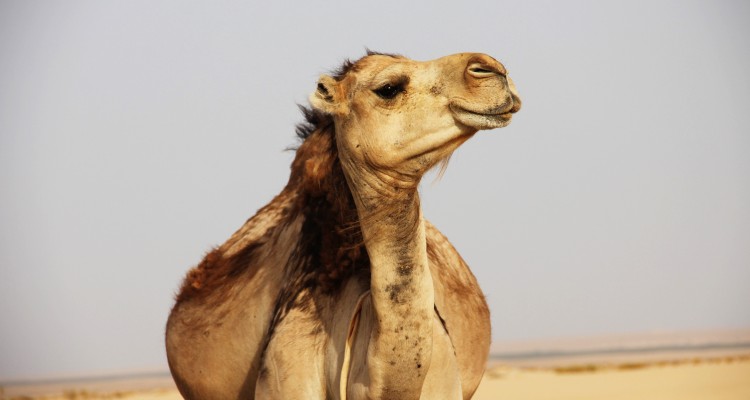This week enjoy the serenity of Carter’s final installment of his Moroccan adventures. Here, he’s ditched the taxis and broken free from the crowded medinas, opting instead, for the wonder and awe of the Sahara Desert.
Carter Hammett
ACT THREE
There’s a local myth that states the Erg Chebbi sand dunes were a punishment manifested by God after rejecting an exhausted traveller from the Sahara. The dunes are supposedly a reminder to never refuse assistance to travellers again. Manifestation of God or not, they are also, without question, one of the great experiences of travelling in Morocco.
Personally, I wonder if that punishment extends to the camel ride I’m on. It’s uncomfortable to say the least, as I try to negotiate a way to “settle in.” Some of the more adventurous folks in our caravan ride side saddle. After a while, the ride becomes almost pleasant as I learn to move with the rise and fall of the sands.
It’s a humbling place, these dunes. I’m grateful for the turban Brahim has introduced us to: it does a marvellous job of keeping the heat off vulnerable heads. Every so often I look back past our caravan and marvel at the history, while imagining the difficulty faced by traders along what used to be the caravan route to Timbuktu.
Rising to 150m, these enormous sand piles stretching to the Algerian border and beyond, are a dazzling sight. The dunes stretch 28km and 7km at their widest area, offering a modest, yet superb sampling of the Sahara’s aura. At summer’s height, brave locals living with the debilitating pain of rheumatism beat back the heat to bury themselves up to the neck in sand that they believe can help manage their pain.
It’s here I learn that sand dunes are actually only a relatively small part of what encompasses a true desert. Rocky outcrops, flat roads, tumbleweed and barren landscapes all contribute to the desert’s actual make up. It’s here when it also sinks in that we’re eating “Moroccan food for white people,” which is actually just fine. Several group members we’re travelling with are either vegetarian or don’t eat red meat, and our hosts generally do a good job of juggling that demand. Our tajine—any number of spiced stews slowly cooked in an earthenware cooking dish with a conical lid—is cooked right in the fire and is among the better meals we’ve eaten on the trip.
It’s dark by the time we’ve finished eating, and after dinner we’re treated to a hypnotic round of music by our Berber hosts and mesmerized by the pulsing rhythms of their percussion instruments. We’re even allowed to have a crack at playing them ourselves. By now the moon has risen high and throws a benevolent glow on our camp. The majority turn in early—it’s going to be an early morning ride back to our bus. But a few in our group choose to scale a dune we sand-boarded on earlier and clumsily, with water in hand, sit in silence marvelling at the vastness of it all. We’re swallowed by the silence.
After our descent, we stumble back to the camp and pile on the covers our hosts have provided. Our collective consciousness gently slips away as we drift off beneath a chilly star-blanket.
********
Even though Morocco’s but an hour’s ferry ride from Spain, it’s shocking to realize how “far” it seems from, well, everything. “People need to know that Morocco is more like the south of Europe,” says El Ouafy. “Its geographical location however, makes the experience feel more like a middle-east country.”
And while it’s true that French and Spanish colonial rule may have indeed been established here once upon a time, it’s the ancient narratives, thousands of years old that remain both dominant and constant. Marrakech was the only urban centre we visited this trip. We made a conscious decision to avoid cities, preferring instead to take in smaller villages for most of the journey. Turned out to be a smart move. The geography is often beautiful in its desolation; Marrakech crackles with chaotic friendliness. With its startling contrasts, this blend of old and new; the shock of poverty bumping into the march of commerce, Morocco is an intensely rewarding experience and dazzling in its contradictions. And d espite these paradoxes—or perhaps, because of them—a trip to Morocco feels like it somehow brings the whole world just a little bit closer to home.
Carter Hammett is a social worker, writer and trainer living in Toronto, Canada. His words and pictures have appeared in The National Post, The Toronto Star, Toronto Sun and Auto and Trucking Atlantic, among others. His latest publication is Book of Disquiet: Dispatches From the Disability Frontlines (2015). Visit his website at www.wordgarden.ca
WHERE TO STAY:
Kasbah Amazir
Km 10 Route des Gorges de Toudra Tinghir
Marrakech: Hotel El Andalous
Avenue President Kennedy
40000 Marrakech
WHERE TO EAT:
Café Le 6
Marrakech
WHAT TO DO:
Maison de la Photographie
This riad museum hosts rotating exhibitions of more than 6,000 original photographs, most of them quotidian scenes taken between 1870 and the 1950’s. The building, one of the medina’s tallest, houses a tea salon on its roof; stop for a steaming cup and take in the view of the city rooftops. 46 Rue Souk Ahal Fes.
WHERE TO BOOK A TOUR:
Nomadic Expeditions
T: 0118 9737 011 F: 0118 9737 698
Skype: nomadicoffice
Email: nomad@nomadic-tours.com



Leave a Reply